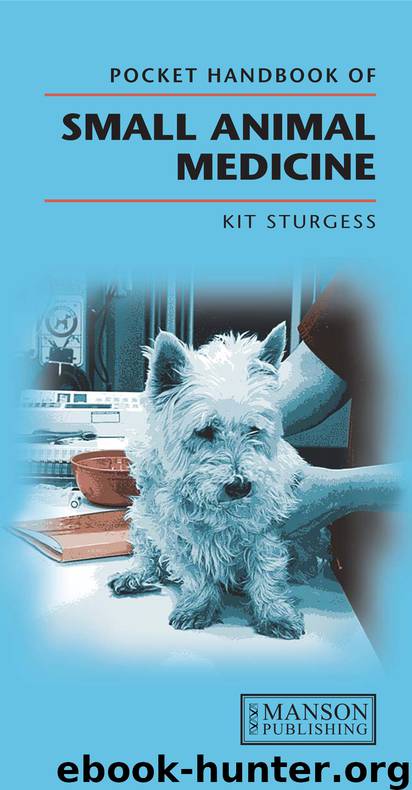Pocket Handbook of Small Animal Medicine by Sturgess Kit

Author:Sturgess, Kit
Language: eng
Format: epub
Publisher: Manson Publishing Ltd
Published: 2012-06-25T16:00:00+00:00
Evaluating the neonate
History: include a breeding history of the household; kennel or cattery management (hygiene, worming, vaccination and so on); health of the dam during the pregnancy; health of the remainder of the litter; age of the puppy/kitten; and the pattern of the illness to date.
Clinical examination is difficult. It becomes more rewarding as the patient gets older and begins to develop adult responses. Neonates show limited responses to disease, initially becoming agitated and crying, progressing to inactivity, hypothermia and loss of the suckling reflex. They deteriorate rapidly with severe infection. Weight gain can be a sensitive indicator of developing problems. Failure to gain weight over any 24 hour period should be investigated.
Systematic approach to examination is essential.
External features: hair coat (amount, condition, parasites); hydration; signs of injury; umbilicus; dewclaws; (docking site); discharge from nose; urine staining (patent urachus); diarrhoea/rectal patency; congenital malformation.
Eyes: swelling under lids indicates pus (often Staphylococcus species); eyes open between 5 and 14 (cats) and 10 and 14 (dogs) days, pupillary light response present within 24 hours of the eyes opening, mild corneal cloudiness usually present as eyes open.
Ears: external auditory meatus opens between 6 and 14 days; check for mites; middle ear infection (bulging tympanum).
Mouth: mucous membrane colour; evidence of cleft palate.
Thorax: regular rhythm; heart murmurs may be functional (usually soft); lung sounds difficult to distinguish but should be present; check symmetry/malformation of the thoracic cavity.
Abdomen: should feel full, but not swollen or tight; liver and spleen not palpable; intestines soft, mobile and non-painful; urinary bladder freely movable.
Neurological assessment: alertness, response to stimulation, suckle reflex; other reflexes appropriate to age; gait (walking from 4 weeks old); posture. Flexor and extensor dominance appears more variable in kittens than puppies.
Download
This site does not store any files on its server. We only index and link to content provided by other sites. Please contact the content providers to delete copyright contents if any and email us, we'll remove relevant links or contents immediately.
The Ultimate Pet Health Guide by Gary Richter(1728)
All Things Bright and Beautiful by James Herriot(1709)
Vet in Harness by James Herriot(1664)
Predation ID Manual by Kurt Alt(1657)
Chimpanzee Politics: Power and Sex among Apes by Frans de de Waal(1480)
Young James Herriot by John Lewis-Stempel(1477)
Veterinary Echocardiography by Boon June A(1379)
All Things Wise and Wonderful by James Herriot(1324)
Creatures of the Rock by Andrew Peacock(1323)
Vet in a Spin by James Herriot(1309)
Zoo Tails by Oliver Graham Jones(1279)
Exotic Animal Hematology and Cytology by Campbell Terry W(1277)
Black's Veterinary Dictionary by Edward Boden(1267)
David Sedaris Diaries by David Sedaris(1240)
Dr. Pitcairn's Complete Guide to Natural Health for Dogs and Cats by Richard H. Pitcairn & Susan Hubble Pitcairn(1166)
Calisthenics: Core CRUSH: 38 Bodyweight Exercises | The #1 Six Pack Bodyweight Training Guide by Pure Calisthenics(1139)
A Handful of Happiness by Massimo Vacchetta & Antonella Tomaselli & Jamie Richards(1124)
Biology and Diseases of the Ferret by Fox James G.; Marini Robert P.; & Robert P. Marini(1096)
Practical Physiotherapy for Veterinary Nurses by Carver Donna;(1036)
